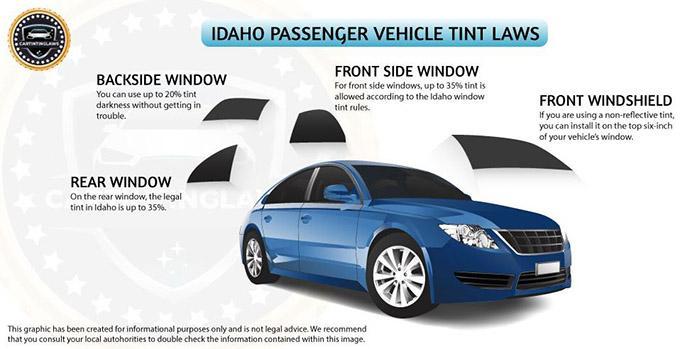Even if you don’t believe it, all 50 states have some kind of law about window tint.
- How Long Can A Spider Live In A Car Updated 04/2024
- Defogging Windshield During Summers Updated 04/2024
- Are You Allowed To Have Tinted Windshield And Windows In Delaware? Updated 04/2024
- What Is The Recommended Tire Pressure For 51 Psi Max Updated 04/2024
- Clogged Exhaust Manifold Symptoms Updated 04/2024
Some states, like Arizona, where the sun shines nearly 365 days a year, are a little more flexible.
You Are Watching: Idaho Tint Laws That You Need Know Updated 04/2024
Idaho, on the other hand, has laws and rules about window tinting that everyone must follow.
You might want to tint your car’s windows to protect your privacy, scare off potential thieves, or keep the interior cool in the summer.
No matter why you want to tint your windows, you should be aware of Idaho’s laws so you don’t get in trouble or pay fines.
Window Tint Standards for Idaho Residents

You might think that the government would have a clear rule about how much tint is allowed.
But Idaho has a few rules about window tint, like the AS-1 line rule and how much light can get through.
The AS-1 Line Rule
Under Idaho law, you can’t put a reflective coating, tint, or screen below the AS-1 line on the windshield of your car.
Most cars have an AS-1 line that goes across the width of the glass about five inches below the top of the windshield.
Idaho law says that tinting can’t be lower than six inches from the top of the windshield if a car doesn’t have an AS-1 line or it’s not easy to see.
Light Transmission
As a general rule, the amount of window tint is based on the amount of light transmission, which is the amount of total light that goes through the windshield or tinting material.
For Idaho, non-reflective window tint must let at least 35% of light through, plus or minus 3% for tolerance.
This rule applies to the front side windows and rear windows on the vehicle.
Read More : Car Makes Noise When Turning Updated 04/2024
With a 3 percent tolerance gauge, non-reflective window tint can cover no less than 20 percent and no more than 35 percent of the side windows.
People can only have windows with a non-reflective tint of at least 70% on the windshield and at least 20% on the other windows if they can show written proof that they need it for medical reasons.
In Idaho, people who have a written pass from a doctor for a medical condition that requires window tint must have that proof ready if they are stopped for having window tint.
How Do You Calculate Your Windows Light Transmission?

Measuring your windows’ light transmission is a bit complicated.
First, you need to use a photometer detector to measure the light source away from the tint or sunscreen on the car.
Once you have that number, you can figure out how much light gets through the tinted window.
To do this, you will use the detector to measure the light source through the tint.
You should find out how much light the tinted material lets through.
If you don’t have a detector on hand, which you probably don’t, you can always talk to the source of the tint.
If you took your car to a shop, they should have a record of what transmission level they used on your car or for the tint in general.
Stickers and Certification for Window Tint in Idaho
In some states, you may have to put a sticker on your windows to show that you’re allowed to tint them, but Idaho does not.
You should, however, always keep medical certification records on you or in your car in case your tinted windows get you pulled over.
In the same way, places and companies that tint windows do not have to prove that the film they sell in Idaho is safe.
This means that if the police pull you over because of your tint, they can’t also go after the company that made it.
Can You Get Pulled Over for Tint in Idaho?
Read More : Best Car Racing Seats (2021 – 2022) Updated 04/2024
In short, yes. Yes.
The long reply?
In Idaho, you can get pulled over for tint if your car doesn’t look like it meets the state’s rules and laws.
If you get pulled over, the officer who is there can ask you about how your windows are tinted and judge them.
If the officer checks your car and finds that the windows don’t meet Idaho state law, you won’t be arrested, but you will get a ticket.
If you get a traffic ticket, you will be given a written warning and have to pay a fine.
In Idaho, the cost of a ticket is $67.
Why Does Idaho Have Window Tint Laws?
Like the rest of the U.S., Idaho has laws about window tinting to protect police officers and other people who work for the law.
When coming up to a car, an officer needs to be able to see inside without any obstructions in order to make an accurate and useful assessment of the situation.
If a car’s windows are so dark that an officer can’t even see who is driving, who knows what the driver might be hiding in the backseat?
So, in 1992, Idaho passed laws and standards about window tinting to protect law enforcement workers.
The general public is also at risk because of windows with tint.
The government enforced the laws to keep the police and the people of Idaho from getting into car accidents.
Just like a police officer needs to see how a driver is moving before pulling them over, a driver should be able to see what other drivers are doing on the road.
For example, if someone is texting while driving and might run a red light, a driver on the other side of the road should be able to see what’s going on to avoid a crash.
Sources: https://micdot.com
Category: Car










